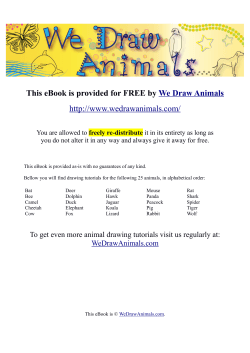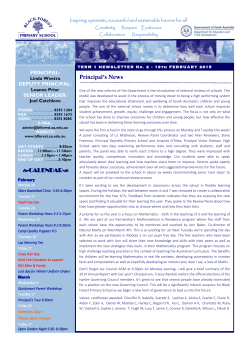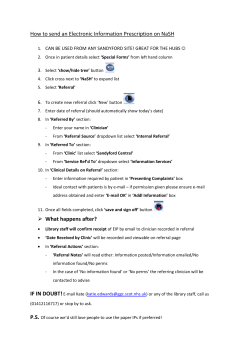
Focus EPBC Act Koala guidelines released
Focus EPBC Act Koala guidelines released Planning and Environment 11 February 2015 WHO SHOULD READ THIS The Commonwealth Government has released finalised referral guidelines (Guidelines) to assist proponents and decision makers in navigating the requirements of the Environmental Protection and Biodiversity Act 1999 (EPBC Act), as it relates to koala conservation. All stakeholders affected by koala habitat. THINGS YOU NEED TO KNOW A loss of as little as two hectares of critical habitat could be considered significant and therefore trigger a controlled action. Background In April 2012, the combined Queensland, New South Wales and Australian Capital Territory koala populations were listed as 'vulnerable' under section 178 of the EPBC Act. This listing means that any action which will have, or is likely to have a ‘significant impact’ on the koala population must be referred to the Commonwealth Minister for approval before the action can commence. The newly released Guidelines supersede the Draft Referral Guidelines released in late 2013, and the Interim Koala Referral Advice, which was released shortly after listing. The new Guidelines follow a similar approach as the Draft WHAT YOU NEED TO DO When planning a project use the new guidelines to assess Guidelines but provide greater clarity on specific matters raised in the public consultation process, conducted in early 2014. the impact it will have on the Purpose The Guidelines aim to address the complexity associated with koala protection koala population. If (including distribution, migration patterns and impacts) and provide guidance appropriate, refer to the which can be applied consistently across jurisdictions. Commonwealth for a determination. The Guidelines are intended to: help decide whether actions should be referred to the Commonwealth for consideration because of a potential ‘significant impact’ on the koala guide on the information expected to support a referral, survey planning, standards for mitigating impacts and other matters, and aid in determining both impacts and offsets for significant residual impacts on the koala in approval decisions. Referral trigger The general Significant Impact Guidelines 1.1 - Matters of National Environment Significance continue to apply to listed Koala species. It states that actions are likely to have a ‘significant impact’ on a vulnerable species if they ‘adversely affect habitat critical to the survival of the species’. Key tools in the Guidelines Habitat assessment tool A loss of between 2 and 20 hectares of habitat critical to the survival of the koala will likely be a significant impact. The Guidelines contain a habitat assessment tool, which can be used to identify this critical habitat. The assessment tool categorises five primary koala habitat attributes, including: koala occurrence vegetation composition habitat and connectivity existing threats, and recovery value. Each of these attributes is scored to indicate the value of the habitat in the impact area. This tool requires input from a suitably qualified expert and will assist in determining habitat quality for any offset requirements. Mitigation tables The Guidelines also contain tables, which discuss mitigation measures for a range of impacts including: dog attacks vehicle strikes spread of disease or pathogens barriers to disbursement and fragmentation, and degradation of habitat through hydrological change. These tables contain desirable measures for reducing impacts on the koala population. They are ranked on their effectiveness in planning, monitoring and maintaining mitigation measures. Transitional arrangements The Guidelines apply to all new referrals and existing assessments of actions, which may impact the koala. If your proposed action has already been referred to the Minister under the EPBC Act, and the Minister has decided whether the action is a ‘controlled action’, the proposal will not be affected. For existing undecided referrals, particular circumstances may require proponents to provide further information about their proposed actions, but as the Guidelines are largely similar to the Draft Guidelines we do not anticipate its introduction will have an onerous impact. If you have not referred an action but the land is subject of the proposal may contain a koala habitat, we recommend that you seek technical advice as to whether the action is required to be referred to the Commonwealth Environment Department, as well as assessment at a State level. Offsets If an action requires Commonwealth approval, offsets that compensate for the significant residual impacts of the action are considered in the assessment and approval stages. Offsets are not relevant considerations at the referral stage. Interaction with State and Local Government The Guidelines do not provide guidance on the requirements under state and local government laws. However, the Guidelines have been prepared in a way that allows for alignment of definitions and assessment processes with those required under state government frameworks. Key Queensland laws include: the Southeast Queensland Koala Conservation Estate Planning Regulatory Provisions (SPRP) - an overarching planning instrument, which regulates new development at the development assessment stage, and Environmental Offsets Act 2014 (Qld), which coordinates the delivery of environmental offsets in conjunction with the Queensland Environmental Offsets Policy 2014 Version 1.1. In addition to the SPRP and Offsets Policy, State government also provides for: State Government Supported Community Infrastructure Koala Conservation Policy 2010 Nature (Koala) Conservation Plan 2006 and Management Program 2006 to 2016, and Koala Sensitive Design Guidelines. Summary Proponents should be aware that approval may be required at the local, state and Commonwealth levels. Any decision not to refer to a project with a potential impact on koalas should be carefully documented, with input from suitably qualified experts, to minimise risk of compliance action in future. If having considered your project and the Guidelines a significant impact is likely, you must submit a referral. Submitting a referral for consideration in any case will provide proponents with a concrete decision from the Department on which they can rely. If the Minister decides that the proposed action is not a controlled action requiring approval, the Department cannot later take enforcement action against the proponent for the subject matter of the referral. For this reason it is important that the referral reflects significance and likelihood of impacts, and where the scope of a project changes the referral should be re-visited. Further information For further information on any of the issues raised in this alert please contact: Stuart Macnaughton on +61 7 3233 8868 Sarah Hausler on +61 7 3233 8563 Madeleine McGann on +61 3233 8645 Focus covers legal and technical issues in a general way. It is not designed to express opinions on specific cases. Focus is intended for information purposes only and should not be regarded as legal advice. Further advice should be obtained before taking action on any issue dealt with in this publication.
© Copyright 2025














